FORD TAURUS 1999 3.G User Guide
Manufacturer: FORD, Model Year: 1999, Model line: TAURUS, Model: FORD TAURUS 1999 3.GPages: 224, PDF Size: 1.42 MB
Page 11 of 224

Air bag readiness
Momentarily
illuminates when the
ignition is turned ON.
If the light fails to
illuminate, continues to flash or remains on, have
the system serviced immediately.
Safety belt warning chime
Chimes to remind you to fasten your safety belts.
For information on the safety belt warning chime,
refer to theSeating and safety restraintschapter.
Supplemental restraint system (SRS) warning
chime
For information on the SRS warning chime, refer to
theSeating and safety restraintschapter.
Key-in-ignition warning chime
Sounds when the key is left in the ignition in the
OFF/LOCK or ACC position and the driver's door is
opened.
Headlamps on warning chime
Sounds when the headlamps or parking lamps are
on, the ignition is off (and the key is not in the
ignition) and the driver's door is opened.
Instrumentation
11
Page 12 of 224
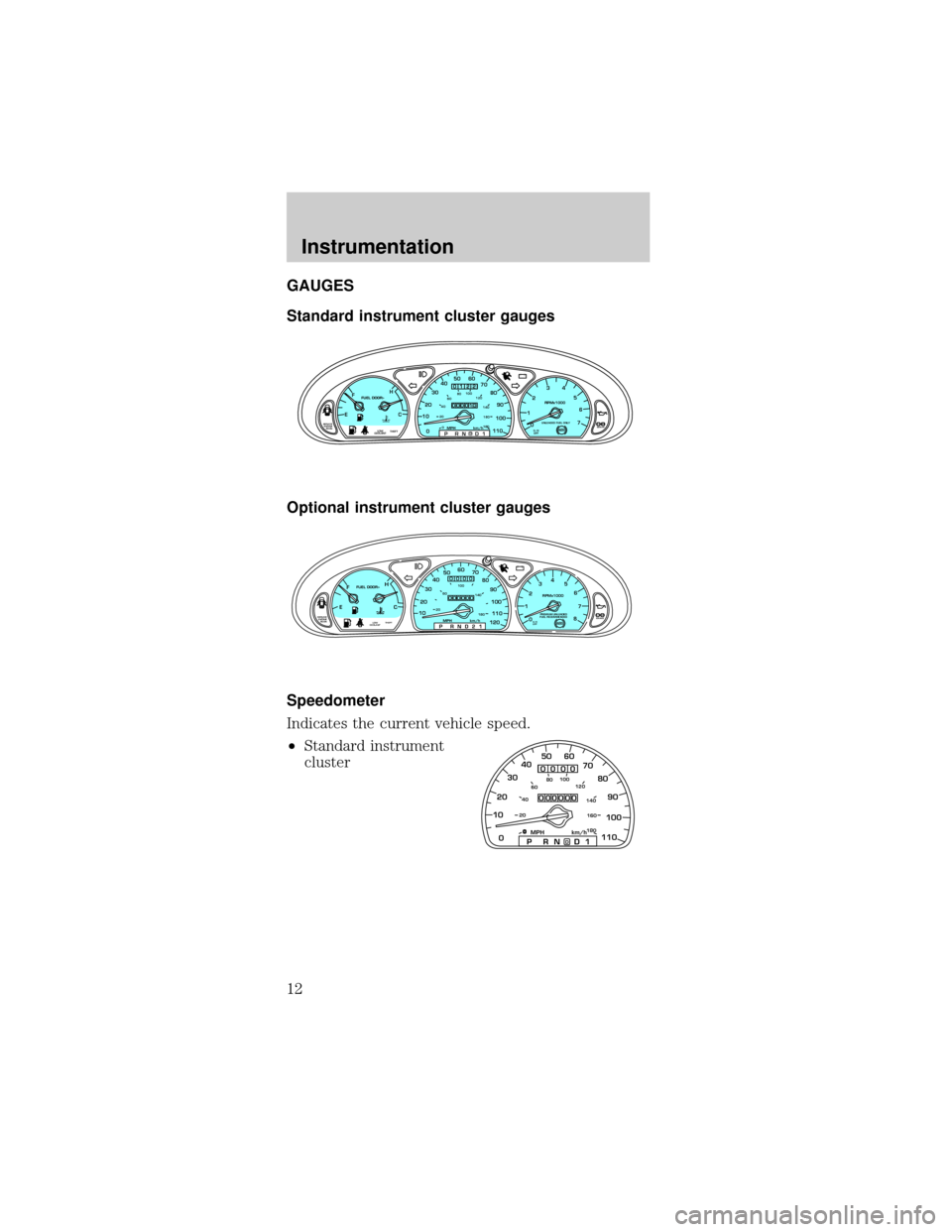
GAUGES
Standard instrument cluster gauges
Optional instrument cluster gauges
Speedometer
Indicates the current vehicle speed.
²Standard instrument
cluster
CRUISE
RPMx1000
0 1234
5
6
7EFC H
FUEL DOOR>
SERVICE
ENGINE
SOON1020304050 60
70
80
90
100
110
00 20406080100
120
140
160
180P R N D D 1MPH km/h
00
122
00013
P!
BRAKEABS
+ –
UNLEADED FUEL ONLY
THEFT LOW
COOLANTO/D
OFF
EFC H
FUEL DOOR>
SERVICE
ENGINE
SOON
THEFT102030405060
70
80
90
100
1202060100
140
180
P R N D 2 1MPH km/h
00
000
00000
P!
BRAKELOW
COOLANT
+ –
110CRUISE
RPMx1000
ABSO/D
OFFPREMIUM UNLEADED
FUEL RECOMMENDED0 1234
5
6
78
1020304050 60
70
80
90
100
110
0
0 20406080100
120
140
160
180P R N D D 1MPH km/h
00
000
00000
Instrumentation
12
Page 13 of 224
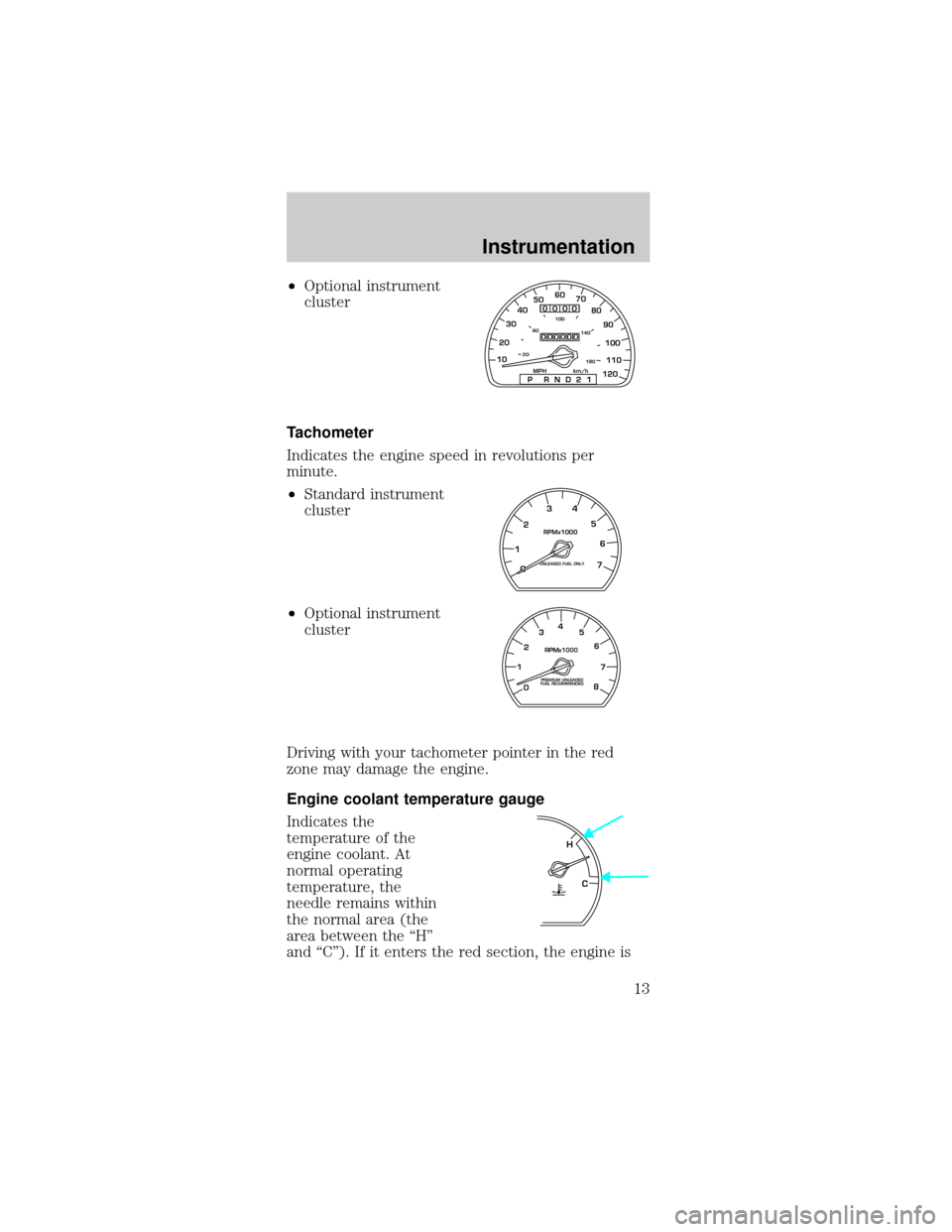
²Optional instrument
cluster
Tachometer
Indicates the engine speed in revolutions per
minute.
²Standard instrument
cluster
²Optional instrument
cluster
Driving with your tachometer pointer in the red
zone may damage the engine.
Engine coolant temperature gauge
Indicates the
temperature of the
engine coolant. At
normal operating
temperature, the
needle remains within
the normal area (the
area between the ªHº
and ªCº). If it enters the red section, the engine is
102030405060
70
80
90
100
1202060100
140
180
P R N D 2 1MPH km/h
00
000
00000
110
RPMx1000
0 1234
5
6
7UNLEADED FUEL ONLY
RPMx1000
PREMIUM UNLEADED
FUEL RECOMMENDED0 1234
5
6
78
C H
Instrumentation
13
Page 14 of 224
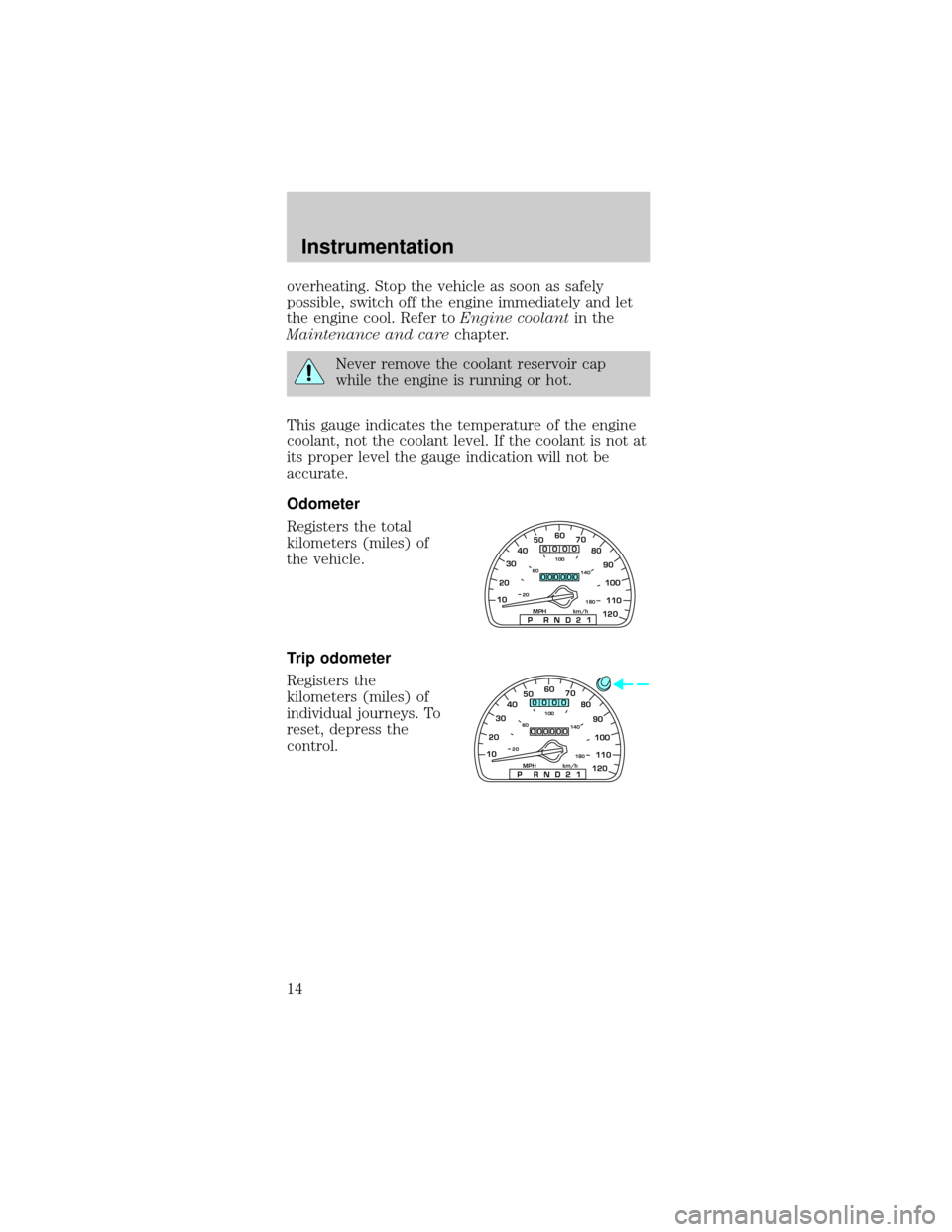
overheating. Stop the vehicle as soon as safely
possible, switch off the engine immediately and let
the engine cool. Refer toEngine coolantin the
Maintenance and carechapter.
Never remove the coolant reservoir cap
while the engine is running or hot.
This gauge indicates the temperature of the engine
coolant, not the coolant level. If the coolant is not at
its proper level the gauge indication will not be
accurate.
Odometer
Registers the total
kilometers (miles) of
the vehicle.
Trip odometer
Registers the
kilometers (miles) of
individual journeys. To
reset, depress the
control.
102030405060
70
80
90
100
1202060100
140
180
P R N D 2 1MPH km/h
00
000
00000
110
102030405060
70
80
90
100
1202060100
140
180
P R N D 2 1MPH km/h
00
000
00000
110
Instrumentation
14
Page 15 of 224

Fuel gauge
Displays approximately
how much fuel is in
the fuel tank (when
the key is in the ON
position). The fuel
gauge may vary slightly
when the vehicle is in
motion. The ignition
should be in the OFF
position while the vehicle is being refueled. When
the gauge first indicates empty, there is a small
amount of reserve fuel in the tank. When refueling
the vehicle from empty indication, the amount of
fuel that can be added will be less than the
advertised capacity due to the reserve fuel.
A minimum of six gallons must be added or removed
from the fuel tank in order for the gauge to
instantaneously update. If less than six gallons is the
change, the gauge will take between five to ten
minutes to update.
EF
Instrumentation
15
Page 16 of 224
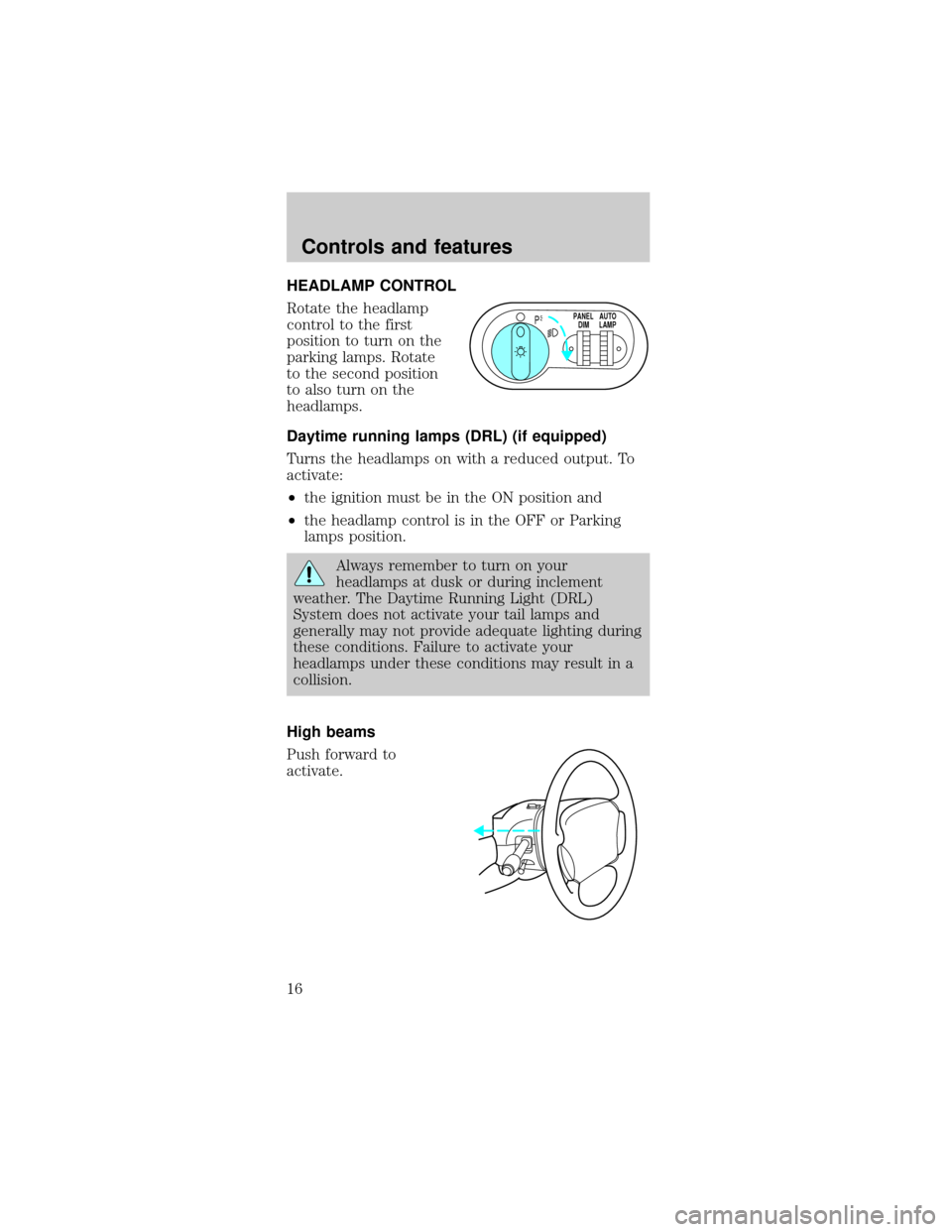
HEADLAMP CONTROL
Rotate the headlamp
control to the first
position to turn on the
parking lamps. Rotate
to the second position
to also turn on the
headlamps.
Daytime running lamps (DRL) (if equipped)
Turns the headlamps on with a reduced output. To
activate:
²the ignition must be in the ON position and
²the headlamp control is in the OFF or Parking
lamps position.
Always remember to turn on your
headlamps at dusk or during inclement
weather. The Daytime Running Light (DRL)
System does not activate your tail lamps and
generally may not provide adequate lighting during
these conditions. Failure to activate your
headlamps under these conditions may result in a
collision.
High beams
Push forward to
activate.
PPANEL
DIMAUTO
LAMP
Controls and features
16
Page 17 of 224
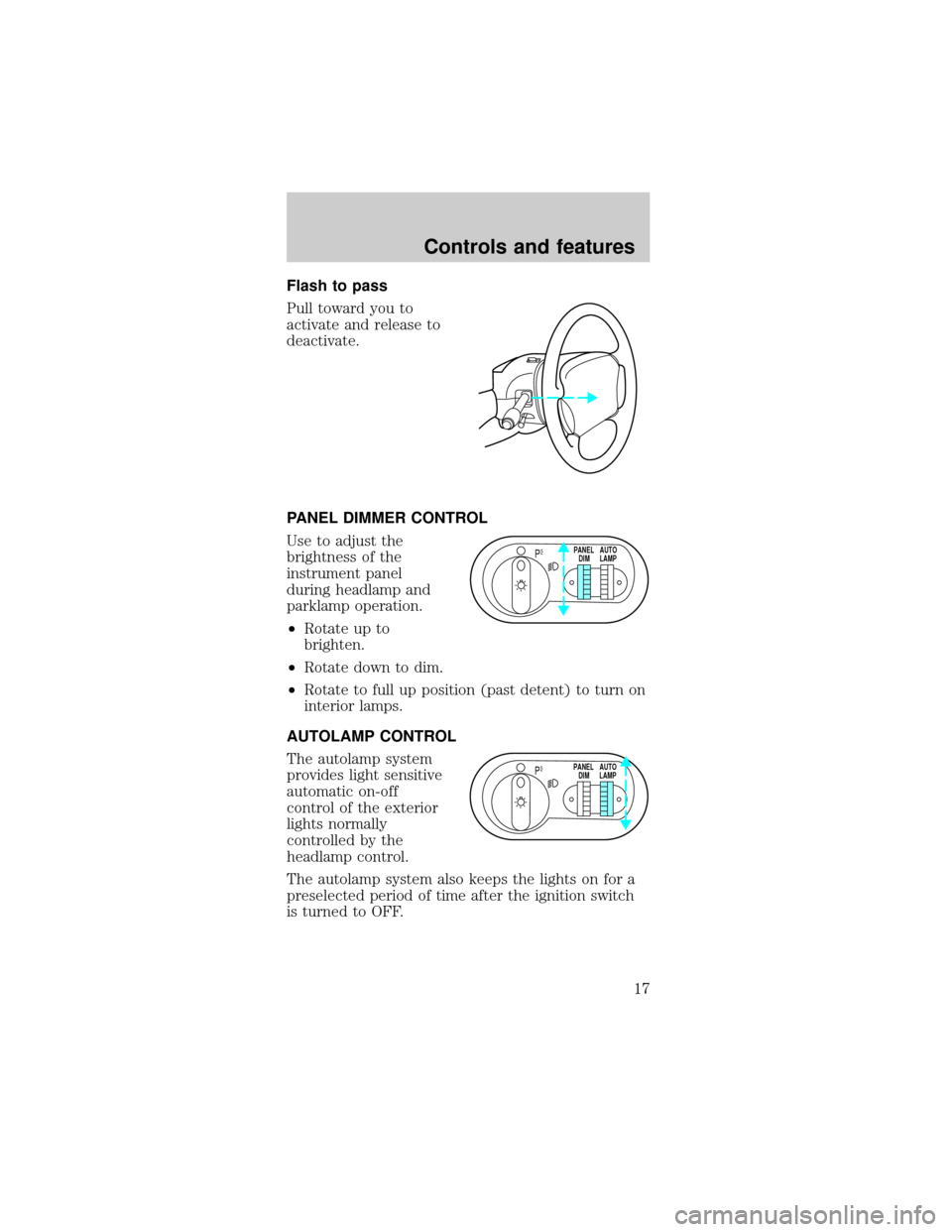
Flash to pass
Pull toward you to
activate and release to
deactivate.
PANEL DIMMER CONTROL
Use to adjust the
brightness of the
instrument panel
during headlamp and
parklamp operation.
²Rotate up to
brighten.
²Rotate down to dim.
²Rotate to full up position (past detent) to turn on
interior lamps.
AUTOLAMP CONTROL
The autolamp system
provides light sensitive
automatic on-off
control of the exterior
lights normally
controlled by the
headlamp control.
The autolamp system also keeps the lights on for a
preselected period of time after the ignition switch
is turned to OFF.
PPANEL
DIMAUTO
LAMP
PPANEL
DIMAUTO
LAMP
Controls and features
17
Page 18 of 224
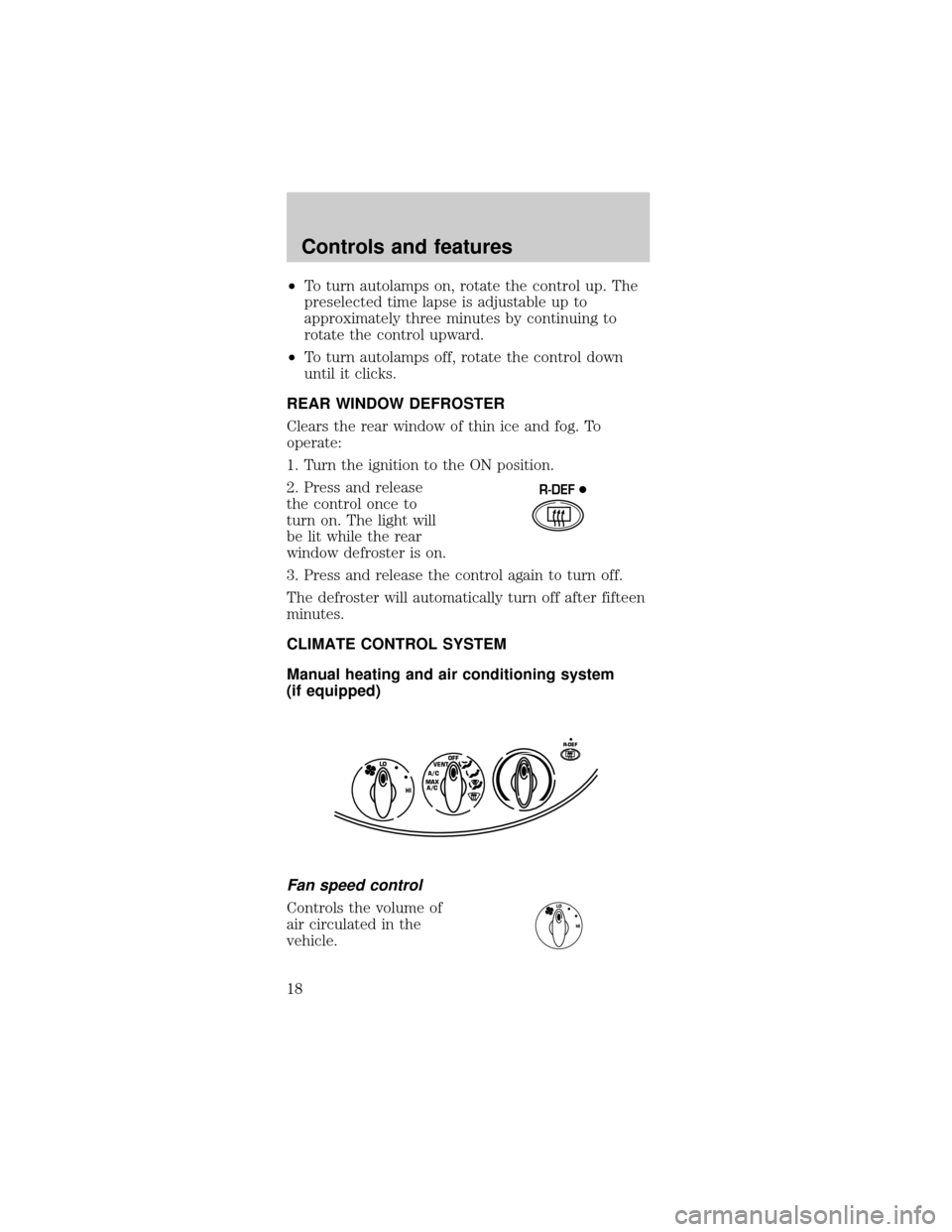
²To turn autolamps on, rotate the control up. The
preselected time lapse is adjustable up to
approximately three minutes by continuing to
rotate the control upward.
²To turn autolamps off, rotate the control down
until it clicks.
REAR WINDOW DEFROSTER
Clears the rear window of thin ice and fog. To
operate:
1. Turn the ignition to the ON position.
2. Press and release
the control once to
turn on. The light will
be lit while the rear
window defroster is on.
3. Press and release the control again to turn off.
The defroster will automatically turn off after fifteen
minutes.
CLIMATE CONTROL SYSTEM
Manual heating and air conditioning system
(if equipped)
Fan speed control
Controls the volume of
air circulated in the
vehicle.
R-DEF
R-DEF
LO
HIOFF
A/C
MAX
A/CVENT
LO
HI
Controls and features
18
Page 19 of 224
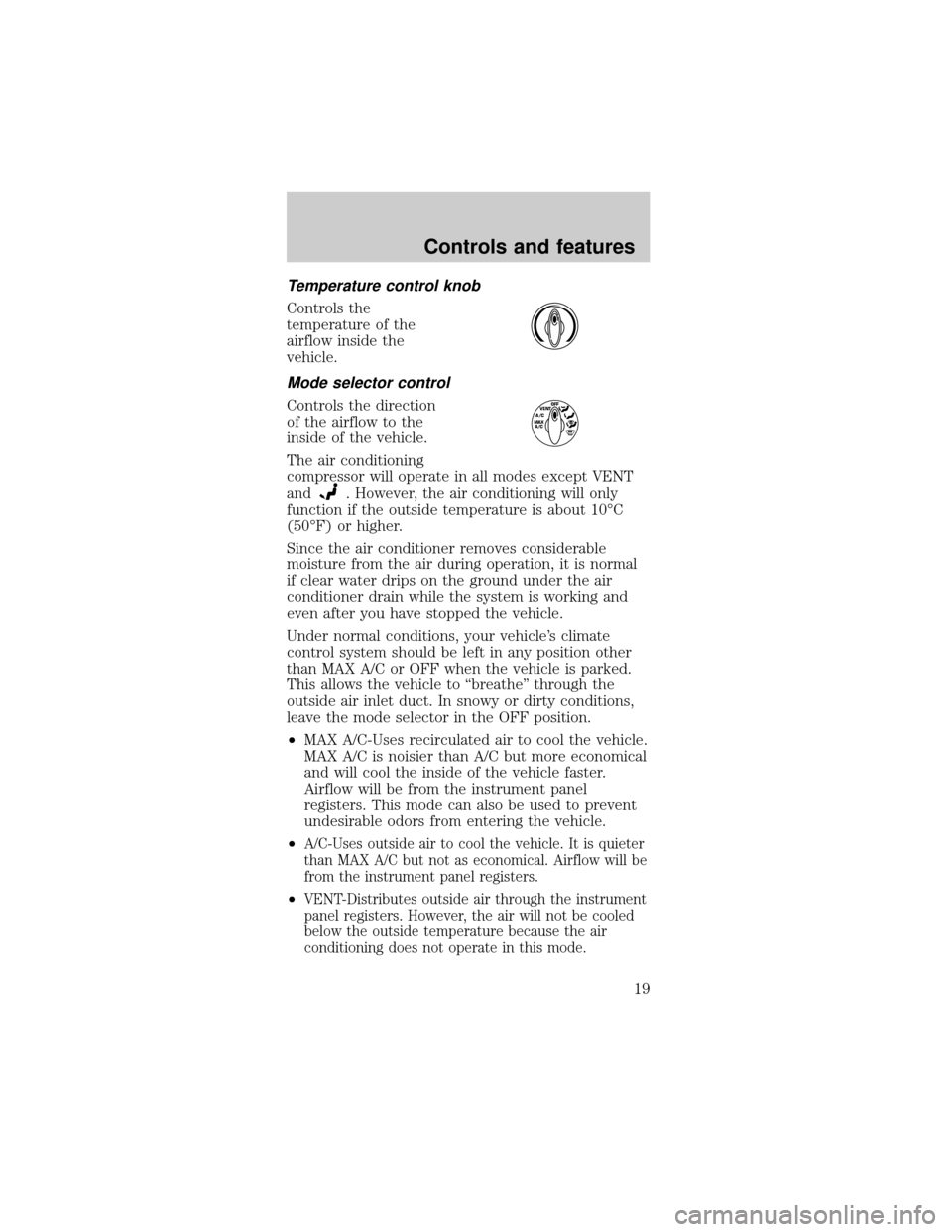
Temperature control knob
Controls the
temperature of the
airflow inside the
vehicle.
Mode selector control
Controls the direction
of the airflow to the
inside of the vehicle.
The air conditioning
compressor will operate in all modes except VENT
and
. However, the air conditioning will only
function if the outside temperature is about 10ÉC
(50ÉF) or higher.
Since the air conditioner removes considerable
moisture from the air during operation, it is normal
if clear water drips on the ground under the air
conditioner drain while the system is working and
even after you have stopped the vehicle.
Under normal conditions, your vehicle's climate
control system should be left in any position other
than MAX A/C or OFF when the vehicle is parked.
This allows the vehicle to ªbreatheº through the
outside air inlet duct. In snowy or dirty conditions,
leave the mode selector in the OFF position.
²MAX A/C-Uses recirculated air to cool the vehicle.
MAX A/C is noisier than A/C but more economical
and will cool the inside of the vehicle faster.
Airflow will be from the instrument panel
registers. This mode can also be used to prevent
undesirable odors from entering the vehicle.
²
A/C-Uses outside air to cool the vehicle. It is quieter
than MAX A/C but not as economical. Airflow will be
from the instrument panel registers.
²VENT-Distributes outside air through the instrument
panel registers. However, the air will not be cooled
below the outside temperature because the air
conditioning does not operate in this mode.
OFF
A/C
MAX
A/CVENT
Controls and features
19
Page 20 of 224
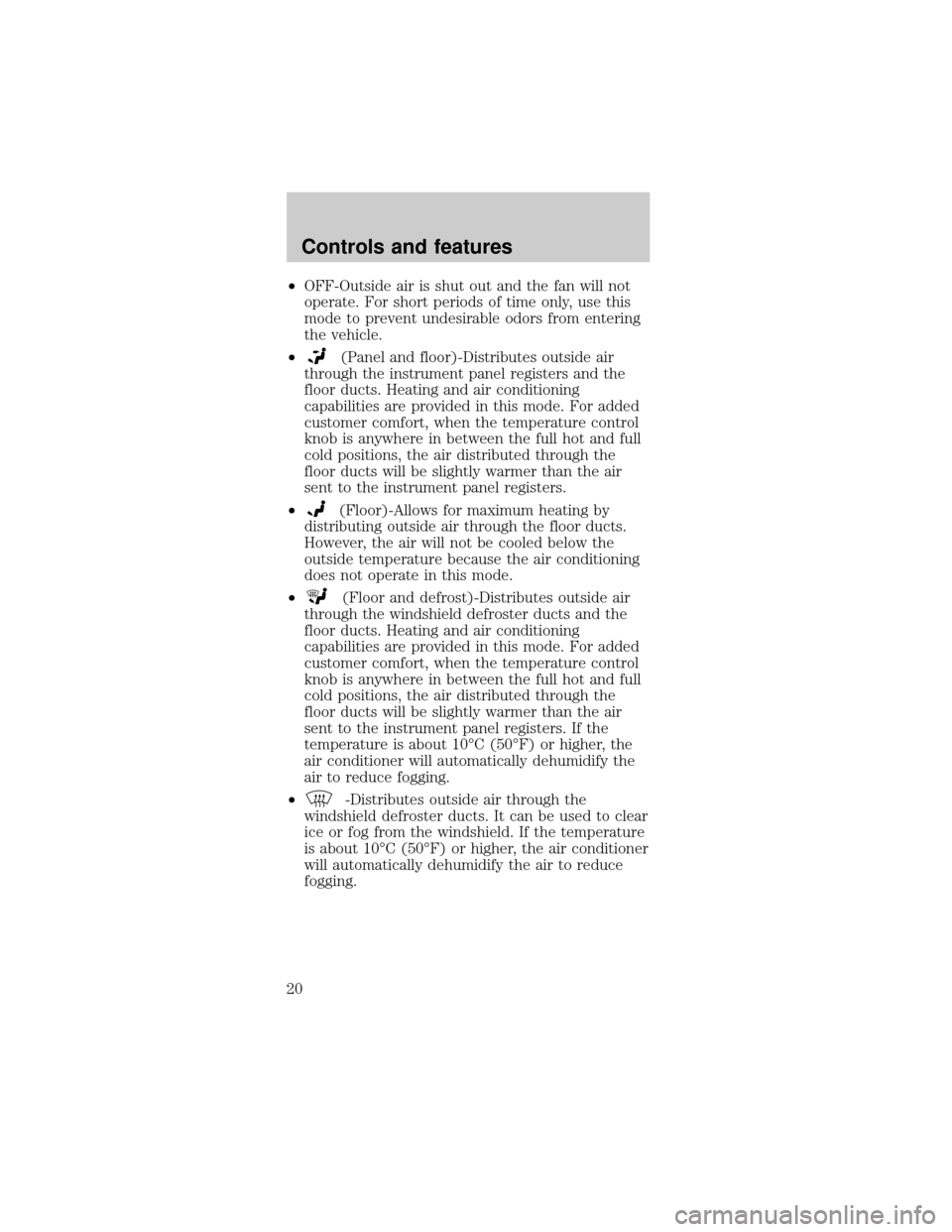
²OFF-Outside air is shut out and the fan will not
operate. For short periods of time only, use this
mode to prevent undesirable odors from entering
the vehicle.
²
(Panel and floor)-Distributes outside air
through the instrument panel registers and the
floor ducts. Heating and air conditioning
capabilities are provided in this mode. For added
customer comfort, when the temperature control
knob is anywhere in between the full hot and full
cold positions, the air distributed through the
floor ducts will be slightly warmer than the air
sent to the instrument panel registers.
²
(Floor)-Allows for maximum heating by
distributing outside air through the floor ducts.
However, the air will not be cooled below the
outside temperature because the air conditioning
does not operate in this mode.
²
(Floor and defrost)-Distributes outside air
through the windshield defroster ducts and the
floor ducts. Heating and air conditioning
capabilities are provided in this mode. For added
customer comfort, when the temperature control
knob is anywhere in between the full hot and full
cold positions, the air distributed through the
floor ducts will be slightly warmer than the air
sent to the instrument panel registers. If the
temperature is about 10ÉC (50ÉF) or higher, the
air conditioner will automatically dehumidify the
air to reduce fogging.
²
-Distributes outside air through the
windshield defroster ducts. It can be used to clear
ice or fog from the windshield. If the temperature
is about 10ÉC (50ÉF) or higher, the air conditioner
will automatically dehumidify the air to reduce
fogging.
Controls and features
20